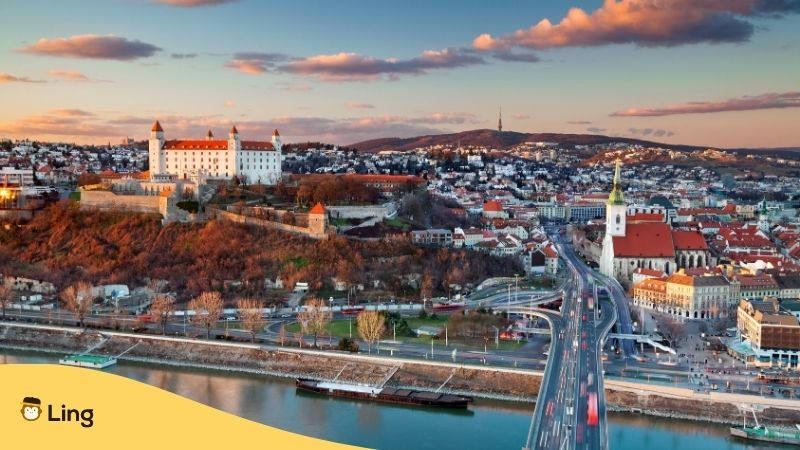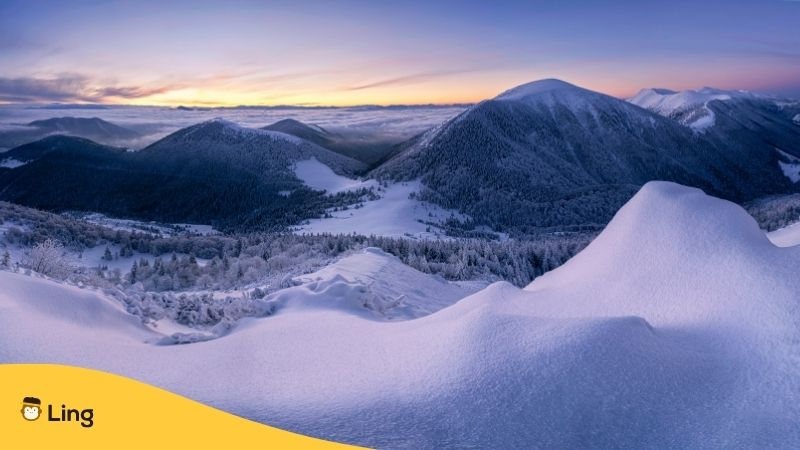Before booking a trip, it is well worth knowing the weather conditions in Slovakia you can expect to encounter when you arrive. In this blog, we will take a quick look at the weather today, and during the year, so you can better plan when to book your flight.
So, if you’re here to learn more about Slovakia by traveling to the country or just learning the language itself, then let’s get to it!
Overview Of Weather Conditions In Slovakia
Because of its location in central Europe, Slovakia is blessed with a temperate continental climate. This means the summers tend to be warm and the winters cool. The highlands of the Tatra Mountains will experience a mountain climate, meaning the summers will be cooler and the winters colder than the lower-lying areas, where the weather tends to be milder during the winter and warmer during the summer. The more mountainous areas record higher rainfall and snow than the rest of Slovakia.
The coldest month in Slovakia is January, when temperatures average around -3 degrees. July and August are the warmest months when temperatures hover around the 27-degree mark, and the daylight hours are the longest. The average temperature for the year for the whole country is 10 degrees. Annually Slovakia receives some 25 inches of rainfall.
If you are planning a trip to Slovakia, the best time to visit is between the middle of May and the end of September. The summers can get hot, but it is usually cooler if you head into the mountains. However, do prepare for sudden rainstorms at higher altitudes.
Regional Weather Conditions In Slovakia
Slovakia is a relatively small country in the center of Europe. The west of the country, where the cities of Bratislava and Nitra are located, is generally flat, and the weather is moderately continental. To the north are the Tatra mountains, where the average temperatures begin to drop. Much of the rest of Slovakia is low mountains and hills that are part of the mighty Carpathians.
While traveling around Slovakia, it’s best to try and memorize some of the words. So, if you’re going to ask what’s the weather in Slovak, you may need a language learning app like Ling. Why not try it yourself by downloading it on the App Store and Google Play?

The Western Plains
The west of Slovakia, where the capital Bratislava is located, is at a lower level and closer to sea level than much of the rest of the country, which is hilly and mountainous. Warm summers and cold winters are to be expected, as this part of the country has a continental climate. Throughout the year, precipitation is common, with thunderstorms and wet days occurring during the late spring and summer.
Bratislava
If you are visiting the nation’s capital city, it is helpful to know what the weather conditions in Slovakia will be like during your trip. During the summer, temperatures can rise as high as 35 degrees, and the days can become very muggy and hot because of the humidity.
This is because warmer air masses move up from the south. In winter, temperatures can drop as low as -20 degrees due to cold air moving in from Russia. Expect to experience intense frosts on the coldest days, and it can be mostly cloudy and dull when the days are wet and drizzly. In winter, the daily temperatures in Bratislava are unlikely to climb much higher than zero degrees. During the height of summer, from July to mid-September, temperatures will average around 28 degrees during the day and 16 degrees at night.
Between May and August, the sun will make an appearance for around half the time. Don’t expect to experience much in the way of sunshine between November and January, when it will be mostly cloudy. Rainfall is evenly distributed throughout the year, with slightly more precipitation in summer. On average, Bratislava sees around 23 inches of rain every year.
Central And Eastern Valleys And Plains
Although the country around Košice also has a continental climate like the west of Slovakia, the winters are generally colder, and the cold spells will last longer. The central-eastern area will spend longer in sub-zero temperatures and precipitation takes the form of flurries of snowfall. During the summer the temperatures are usually warm, but thunderstorms regularly put in an appearance in the afternoon.

Hills And Mountains
Much of the land to the north and the east of Slovakia is a few hundred meters above sea level. This means the climate is slightly colder than in the lower-lying west of the country. Snow, when it falls, is likely to lie longer on the ground in winter. In summer, the temperatures are cooler and more bearable than in the rest of the country, making the regions around Poprad the place to go for those who want to get out and about to explore the stunning countryside.
A colder climate is to be expected in Slovakia’s more mountainous areas. The Tatra Mountains have frigid winters where the temperatures regularly drop below freezing, and snowfall can be heavy. As with other parts of the country, a thunderstorm is likely to put in an appearance in the afternoon during the warmer summer months. The wind speed can be bracing at higher altitudes. At over 2,000 meters above sea level, the average temperature during the summer is 7 degrees, and during the winter -8 degrees. It is also not unusual for snow to fall during the summer months.
Best Time To Visit Slovakia
If you are planning a trip to Slovakia, the best time to go is between May and September. Visiting during these months will mean avoiding the worst of the warm mugginess, especially in the lowlands to the east. Expect to put up with the frequent thunderstorms in the afternoons, although they are usually short-lived and shouldn’t interrupt the sunshine for very long. The evenings and nights are usually pleasantly cool. If you plan to head into the mountains, expect some cloudiness, and it can get a bit chilly at night.
What To Pack
Summer
In summer, it is a good idea to bring shorts and a T-shirt for during the day as well as a jumper and long trousers for the cooler evenings. Wet weather gear is also useful if you get caught in a thunderstorm. A sturdy pair of walking shoes and warmer clothing might be required if you are heading into the mountains.
Winter
Prepare for chilly Christmas weather by packing a scarf, gloves, a woolly hat, and a warm coat, as well as other clothes to keep you warm.
Useful Weather Words In Slovak
Knowing how the weather is going to be every day is now a daily habit we all have, and if you’re in Slovakia and you’re trying to decide if you should take your umbrella with you, you’ll want to turn in the weather channel.
To help you understand the advice from the weatherman, here is a list of a few words about the weather that you most certainly will find useful while in Slovakia.
Prepare For Anything When Visiting Slovakia With The Ling App
As well as being ready for anything the weather will throw at you when traveling to Slovakia, it is a great idea to download a language app before you go. This will help you deal with any linguistic hurdles you might encounter, such as booking a hotel, ordering food, and making new friends.
With the Ling app, you will be better able to brush up on a few useful words and phrases before you arrive.



























